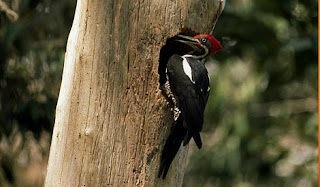 If you hear a loud hammering sound in the woods, you may be listening to a pileated woodpecker. It's one of the largest woodpecker species in North America. (The imperial woodpecker of eastern Mexico, and the ivory-billed woodpecker of the southeastern United States, which may be extinct, are larger.)
If you hear a loud hammering sound in the woods, you may be listening to a pileated woodpecker. It's one of the largest woodpecker species in North America. (The imperial woodpecker of eastern Mexico, and the ivory-billed woodpecker of the southeastern United States, which may be extinct, are larger.)
The look of a pileated woodpecker is unmistakable. It's a large black bird with white on each side of its neck and a red crest on its head. When it flies, white flashes are visible under its wings. The pileated woodpecker is the only woodpecker in North America that is big, black, and has a red crest.
The sound of the pileated woodpecker's hammering carries a long distance through the woods where they live. These woodpeckers drum to attract mates and to establish the boundaries of their territory—warning other males away.
The sounds pileated woodpeckers make as they search for food are loud, too. They use their beaks to peck and dig under bark to find carpenter ants, beetle larvae, and other insects. They often dig large, rectangular holes in trees to uncover their meals.
 Some holes are so big that they weaken young trees, especially if the trees are small. The birds also strip pieces of bark from trees looking for food. Generally, however, pileated woodpeckers help keep a forest healthy by eating wood-boring insects and keeping insect populations under control.
Some holes are so big that they weaken young trees, especially if the trees are small. The birds also strip pieces of bark from trees looking for food. Generally, however, pileated woodpeckers help keep a forest healthy by eating wood-boring insects and keeping insect populations under control.
A nesting pair of pileated woodpeckers usually picks a large, older tree. They make a hole to nest in. During the day, both parents take turns incubating, or sitting on, the eggs to keep them warm. At night, only the male incubates the eggs.
Pileated woodpecker mothers generally lay four eggs at a time. It takes about two weeks for the eggs to hatch. The young birds are ready to fly after about a month.
 FAST FACTS
FAST FACTSThe scientific name of the pileated woodpecker is Dryocopus pileatus.
The pileated woodpecker's body is 16 to 19 inches (41 to 48 centimeters) long. Its wingspan is 26 to 30 inches (66 to 76 centimeters) wide. It weighs between 8.8 and 12.3 ounces (0.25 and 0.35 kilograms). In addition to insects they find in trees, pileated woodpeckers also sometimes eat fruits and nuts.
The pileated woodpecker has a long, barbed tongue and sticky saliva which it uses to capture prey like ants and beetle larvae.
The call of a pileated woodpecker is a loud kuk-kuk-kuk. Pileated woodpeckers live in forests that have large trees, which they need to roost and nest in.
Carpenter ants are the pileated woodpecker's favorite food.
It can take a pileated woodpecker pair six weeks to finish making their nest cavity.
Pileated woodpeckers are important to forest ecology. Their abandoned nest cavities provide homes for other birds, small mammals, and other animals.
Worldwide, there are more than 200 species of woodpecker.
Worldwide, there are more than 200 species of woodpecker.
Woodpeckers generally have strong claws and stiff tails, which they use to prop themselves on the sides of tree trunks as they search for insects to eat.
Woodpeckers' skulls are specially adapted to withstand the pounding they take when searching for food inside trees.
Woodpeckers' skulls are specially adapted to withstand the pounding they take when searching for food inside trees.
No comments:
Post a Comment